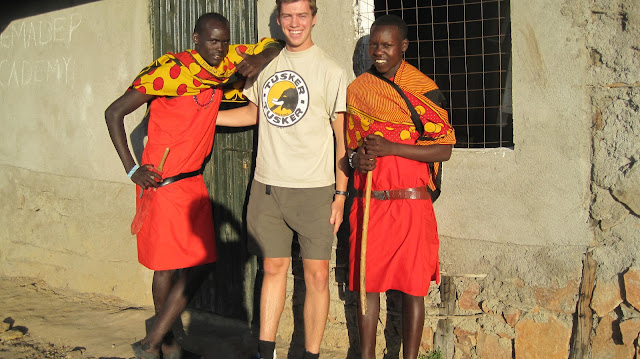Having spent the first week in Kenya with Quaker communities and other friends, visiting and volunteering, we did not want to leave Kenya before taking a safari. So yesterday we were driven to the far western side of Kenya where it borders Tanzania. On the Tanzania side is Serengeti National Park, and on the Kenyan side it is called Maasai Mara Game Reserve. That is where we are. We are staying in a campground with some amenities – iron beds, those big canvas tents that you can stand up in, and a bathroom with running water. I would compare the level of luxury to an AMC hut – in other words, luxurious camping. We are provided beautiful hot meals, chicken and mashed potatoes with a tomato coriander sauce, and fresh fruit. Since it is the off season, we are the only guests. It is quiet and lovely.
We are in the forest, and the nights are very dark. Though the campground area is surrounded by tall thorn bushes, two Maasai men stay awake outside all night protecting us. Last night I heard their quiet talk in the dark, punctuated by long silences. Then came the unmistakable sound of lions roaring in the distance. This morning I hear fabulous and exotic bird sounds, with the lowing of Maasai cow herds as they are taken out to pasture.
To give a list of the animals we saw would be as boring as looking at someone else’s safari slides. Perhaps I should say that when our van approached the first herd of zebra, their dramatic black and white stripes absolutely filled my field of vision. Watching the baby elephants splash in the water within a few feet of us, seeing the gorgeous colors of the lilac-breasted roller bird or the head-feathers of the Abyssinian crane, the national bird of Uganda – all these things took our breath away. We saw one of only 2500 black rhinos left in the world, as so many have been killed for their horns. It stood near us regally, then turned and trotted off with a surprising speed despite its huge backside!
This morning we got up before dawn to see the animals at their most active. We saw lions eating a fresh kill – a wildebeest, those strange dark grey hoofed animals with the bearded faces. The tiny dik-diks raced away from us behind the bushes, and the refined impalas with their brown racing stripe and curved horns cavorted with each other on their elegant hooves looking like dancers.
The hooved animals are all variants of each other. The poor hartebeest drew the short straw, with stubby horns, a long face, and a dull brown hide. On the other hand, the topi with its beautiful glossy brown fur has a black burnishing on its flanks that is exotic and lovely.
We went to where the Mara River meets the Tanzanian border, and there lie the crocodiles in the rushing brown water. The stench rises from their recent kills, whose bodies lie bloated in the shallows, while bones from their earlier kills lie bleached along the river banks.
We were accompanied on our trip by David, our taciturn driver, and Dennis, a young Maasai man who knows best where the animals can be found. Dennis sat in front wearing his short red tunic and his clan’s trademark yellow shawl with enormous red polka dots. He told us this fabric identified him as a young person. Dennis has a year to go in boarding school, after which he hopes to attend university in Nairobi and become a surgeon. He is preceded by another young man in the village who is attending university now, the village’s first university student. Dennis is home over the holidays with his mother only, since his father was killed a few years ago by a water buffalo and his older siblings are away. His English is very good, and he is interested in sharing his culture with us.
We visited his village, where we were impressed at the cultural pride of the Maasai people. Maasai men can be seen all over western Kenya, wearing their bold red, pink and purple cloaks. All around the game reserve where we were, Maasai people have their villages, their enormous herds of cows and goats. They are wealthy in cattle, and they live very close to their animals. Their simple mud huts are built in a circle surrounded by thorn bushes, and at night the animals are brought into the middle of the circle for safety. Calves and baby goats sleep in a room in the hut with their masters. The Maasai alone among Kenyan tribes have chosen to retain their traditional ways, relying very little on money or the dominant culture. Though I am glad not to have been invited to share their traditional diet of cow’s blood, milk and meat, we all were so glad to have visited Dennis’ village and to see his people’s way of life. The image of tall Dennis with his shy smile and downy growth on his chin stays with me, and I pray that he is able to move through the modern world and bring back his training to help his people as he hopes.
Oh awlright, here are some photos....
 |
| Almost life size giraffe |
 |
| Elegant Impala |
 |
| Comparing notes with a baboon |
 |
| Zebras with flamingos in background: Lake Nakuru |
 |
| Our tent at Maasai Mara |
 |
| An old pal |
 |
| Evan with Dennis and Steve |
 |
| Going home for Christmas with live chickens on top |
No comments:
Post a Comment